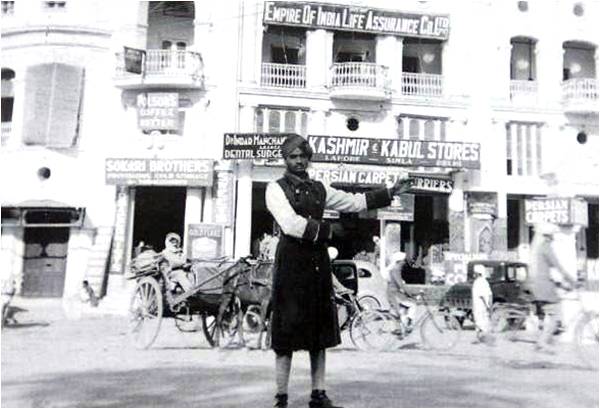
A constable regulates traffic at Regal Square on the Mall in Lahore. Brigadier Francis Ingall, one of the last of the famed Bengal Lancers, wrote the following about his visits to Lahore in the 1930s:
"The main street of Lahore was the Mall. Every station had its mall, a sort of refined high street, but Lahore's was particularly fine. Almost one hundred feet wide, it ran for miles through the Civil Lines – the civilian part of the city – and along the whole length were planted rows of stately plane trees. On one side there was a tanbark riding track and one could ride a horse right out of Lahore without ever crossing tarmac. Every winter the Public Works Department put down new tanbark so that it always looked tidy and groomed.
In the center of Civil Lines, facing down the Mall, was a splendid mansion: Government House, where his Excellency the Governor of the Punjab lived. On the upper part of the Mall were a number of English shops; these had no branches in the outlying stations so one tended to save one's serious shopping for a trip to Lahore. The shops included a haberdashery, a jeweller's shop, a tailor's and a lovely confectionary-cum-coffee shop called Lorang's. Mr Lorang was a Swiss and he sold delicious cakes, coffee and tea; here one could sit and watch the world go by on the Mall.
Motor cars were few and far between in those days; most of the traffic was made up of tongas, the indigenous pony and trap, or bicycles. The streets were also thronged with pedestrian, from multi-hued coolies carrying loads on their heads to elegant foreigners strolling with their ladies. It was a kaleidoscopic picture.
Like other big cities in northern India such as Delhi and Peshawar, Lahore was visited every winter by what was vulgarly termed 'the fishing fleet': young ladies who had come out from England to find a husband."
"The main street of Lahore was the Mall. Every station had its mall, a sort of refined high street, but Lahore's was particularly fine. Almost one hundred feet wide, it ran for miles through the Civil Lines – the civilian part of the city – and along the whole length were planted rows of stately plane trees. On one side there was a tanbark riding track and one could ride a horse right out of Lahore without ever crossing tarmac. Every winter the Public Works Department put down new tanbark so that it always looked tidy and groomed.
In the center of Civil Lines, facing down the Mall, was a splendid mansion: Government House, where his Excellency the Governor of the Punjab lived. On the upper part of the Mall were a number of English shops; these had no branches in the outlying stations so one tended to save one's serious shopping for a trip to Lahore. The shops included a haberdashery, a jeweller's shop, a tailor's and a lovely confectionary-cum-coffee shop called Lorang's. Mr Lorang was a Swiss and he sold delicious cakes, coffee and tea; here one could sit and watch the world go by on the Mall.
Motor cars were few and far between in those days; most of the traffic was made up of tongas, the indigenous pony and trap, or bicycles. The streets were also thronged with pedestrian, from multi-hued coolies carrying loads on their heads to elegant foreigners strolling with their ladies. It was a kaleidoscopic picture.
Like other big cities in northern India such as Delhi and Peshawar, Lahore was visited every winter by what was vulgarly termed 'the fishing fleet': young ladies who had come out from England to find a husband."

